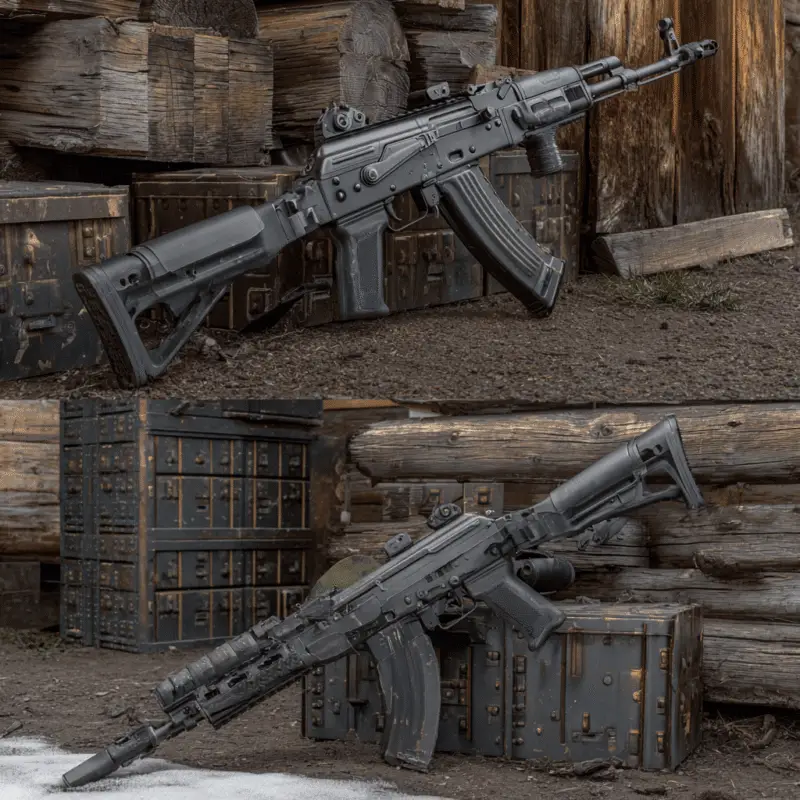Blog
Brotherhood of the Kalashnikov KR9

Communities often form in surprising ways. Some come together around music, others around cars, and some, like the one I found myself in, around a rifle that carried both heritage and modern practicality.
The Kalashnikov KR9 and its sibling, the KUSA KP9, weren’t just firearms—they were a language. And across the United States, people who spoke that language were finding each other.

It started at my local range. On a warm Saturday morning, I noticed three shooters gathered near the far bench. They had laid out their gear neatly: a pair of AR-15s, a shotgun, and two compact carbines I recognized instantly—the Kalashnikov KP9 and the Kalashnikov KR9. Their cases were scuffed, the rifles worn in a way that suggested real use, not just safe queens.
When I struck up a conversation, it felt like I had stumbled into a family I hadn’t known existed. They spoke about their experiences with the rifles as if they were old friends. One of them, a retired Army reservist, explained why he preferred the platform over others: “It’s simple. No gimmicks. And with the KR9 magazine, I know it’ll feed, no matter what.”
The others nodded in agreement, echoing similar praise for the KP9 magazine. What surprised me wasn’t the praise itself—it was how natural and universal it seemed. For them, the magazines weren’t a selling point; they were a given, part of why the rifles earned trust so quickly.
That day turned into a ritual. Every other weekend, the same group gathered, and soon, I joined them. Before long, we were swapping gear, comparing notes, and experimenting with drills. My Kalashnikov KR9 became part of the circle, while another shooter brought his Vityaz KP9 imported years ago. We passed rifles back and forth, curious to see how American-made KUSA KR9 and KUSA KP9 stacked against the Russian lineage.
The conclusion was always the same: the American builds held their ground. In fact, many of us admitted we preferred them, especially with parts and KR9 magazines more readily available stateside. That sense of accessibility helped grow the community even further.
The twist came when one of our members—a soft-spoken middle school teacher—confessed that he had introduced the Kalashnikov KP9 to his robotics club. At first, we laughed, unsure what he meant. But he explained that his students, fascinated by engineering, were studying the ergonomics and design of the KP9 magazine compared to other firearm platforms. “It’s not about shooting,” he clarified. “It’s about understanding mechanical efficiency. And the KP9 is one of the cleanest examples of design simplicity done right.”
Hearing that floored me. The rifles weren’t just bridging gaps between shooters; they were quietly inspiring future engineers. The Kalashnikov KP9 and Kalashnikov USA KR9 were moving beyond gun culture—they were becoming case studies in craftsmanship and design thinking.
At the same time, online communities were exploding. Forums dedicated to AK platforms had entire sections buzzing about the KR9 and KP9. Threads with titles like “Best upgrades for your KUSA KR9” or “Durability test: 5,000 rounds through a KP9 magazine” filled with photos, range reports, and honest discussions. It wasn’t about hype; it was about shared experience.
I joined one of these groups, and within weeks I had made friends from across the country. A machinist in Texas sent me a custom sling adapter he’d made for his Kalashnikov KR9. A father in Ohio shared videos of his teenage daughter confidently running reloads with her KUSA KP9, proud of how she’d mastered the rhythm of the platform. Even a small-town sheriff from Montana chimed in, explaining that he’d swapped his department’s aging pistol-caliber carbines for Kalashnikov KP9s after extensive testing.
What tied all these stories together was trust in the magazines. Again and again, shooters highlighted how the KR9 magazine and KP9 magazine worked without fail. They had become a shorthand for reliability—mention them in a thread, and everyone knew what you meant.
But beyond reliability, there was something deeper happening. The rifles and their mags were cultivating friendships. At one point, a dozen of us from the forum decided to meet up at a national range event. Strangers from different states, backgrounds, and careers all came together around two rifles and their shared DNA.
When we finally met, the energy was electric. We compared gear, swapped Kalashnikov KP9 stories, and even staged informal competitions—who could reload their KR9 magazine fastest, who could clear malfunctions under pressure (though malfunctions were rare). Laughter echoed across the range, and by the end of the day, I realized we weren’t just shooters anymore—we were a brotherhood.
The most powerful moment of that event came at sunset. One member, a firefighter from California, raised his KR9 and spoke quietly: “This rifle, this community—it’s more than a hobby for me. It’s a reminder that simplicity and resilience still matter. In life and in the things we choose to trust.”
We all fell silent for a moment, each of us recognizing that truth. The Kalashnikov KR9, the KUSA KP9, their mags, their heritage—they weren’t just tools. They were bridges. Between people, between generations, between cultures.
Back home, as I cleaned my rifle and stacked my KR9 magazines, I thought about how rare that kind of connection was. Not many products—let alone firearms—could inspire that kind of loyalty, camaraderie, and genuine respect. But somehow, this one did.
The brotherhood of the KR9 wasn’t planned. It wasn’t marketed. It simply grew, born from reliability, simplicity, and a heritage that proved itself over and over. And as I sat there, wiping down the bolt, I realized the truth: this community wasn’t slowing down. It was only growing stronger.
